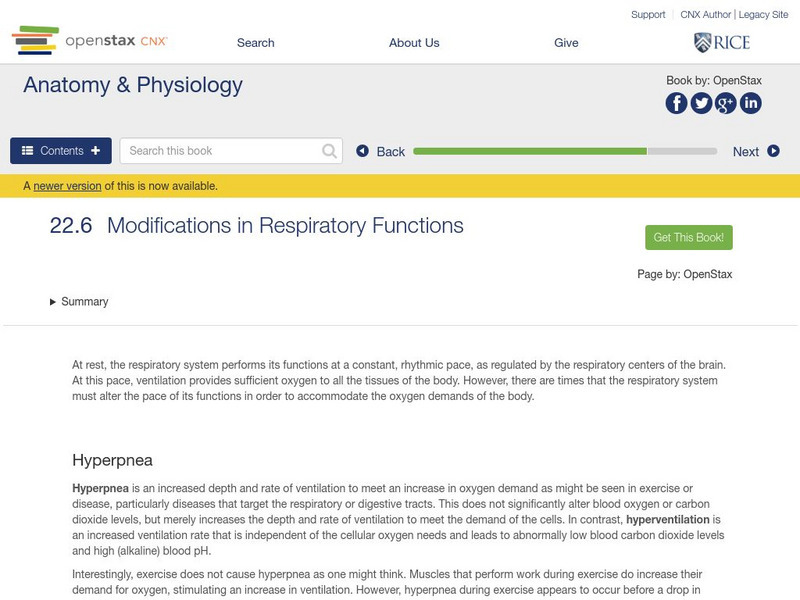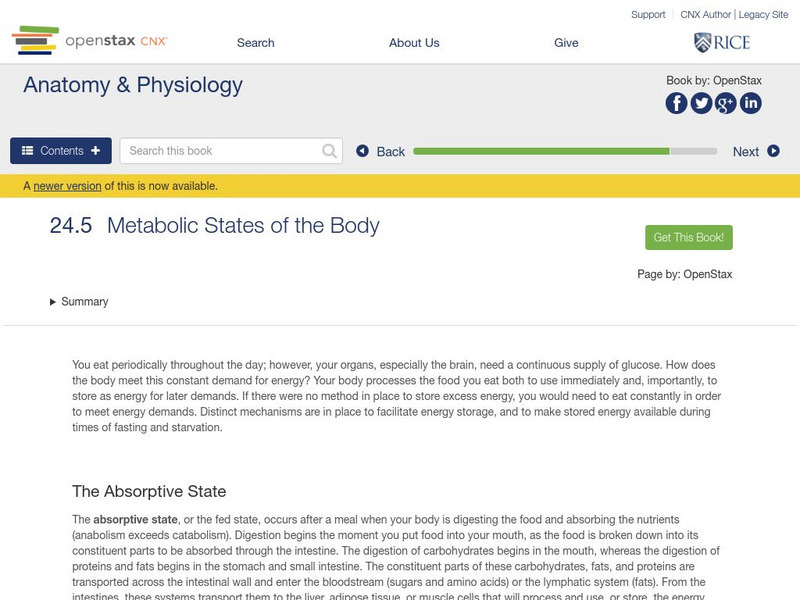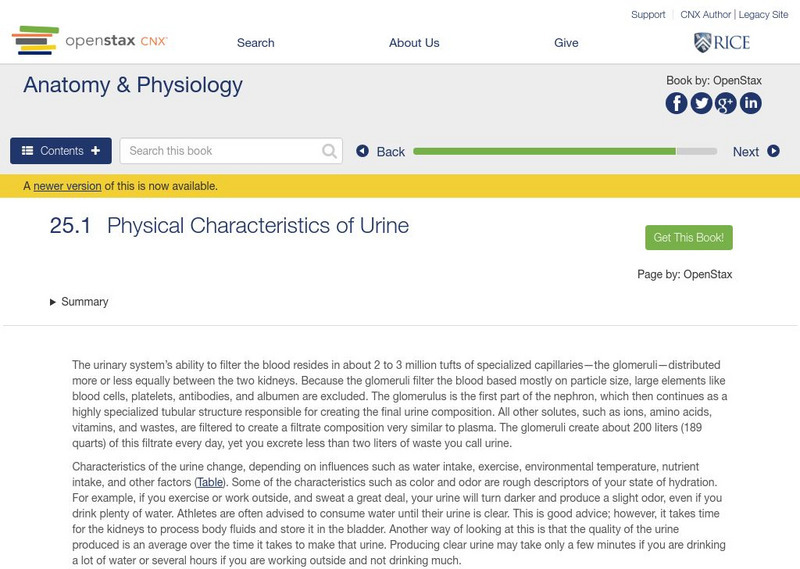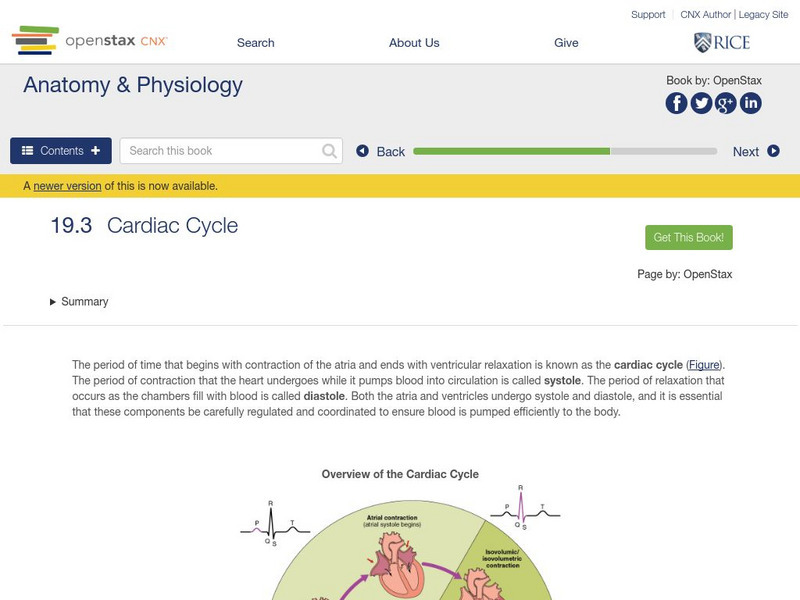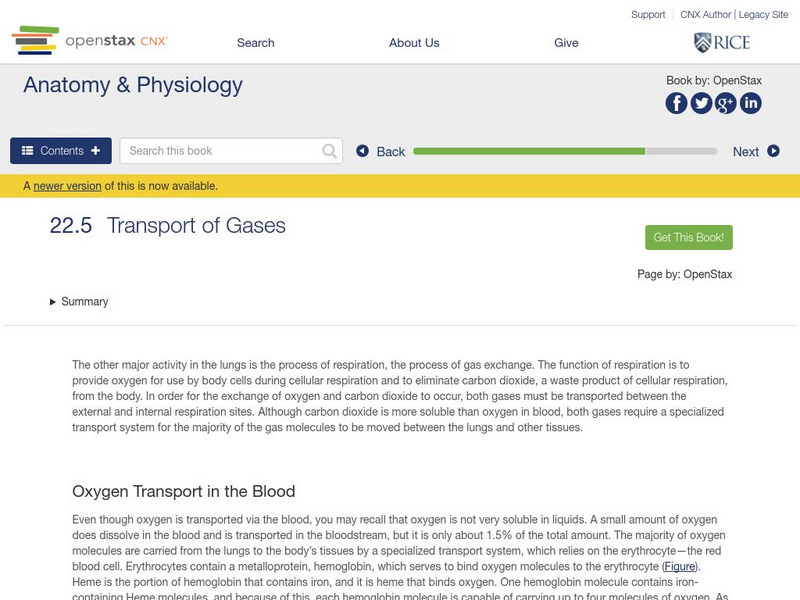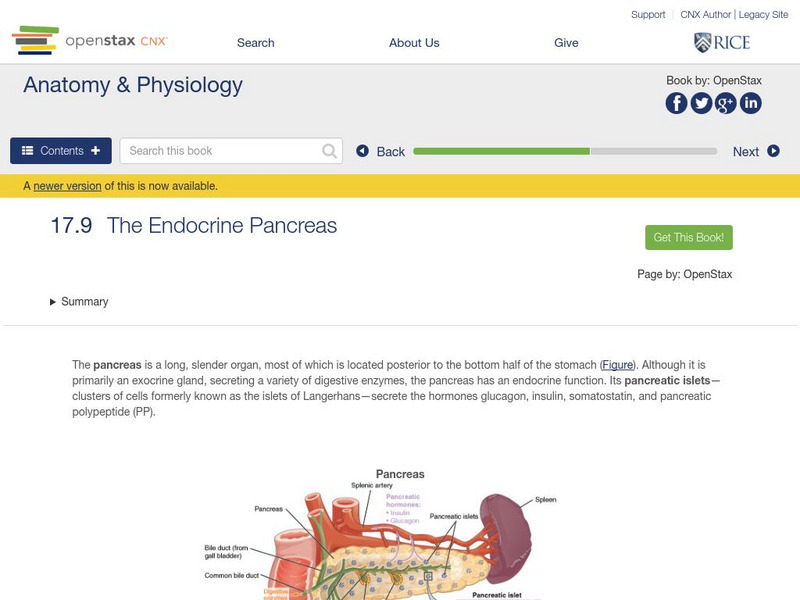OpenStax
Open Stax: Anatomy & Physiology: Modifications in Respiratory Functions
Students learn how the human respiratory system undergoes modifications when the conditions change. Included are the processes of hyperpnea, hyperventilation, and acclimatization.
OpenStax
Open Stax: Anatomy & Physiology: Protein Metabolism
Students will learn how the body digests proteins, and will explain how protein can be used for energy.
OpenStax
Open Stax: Anatomy & Physiology: Metabolic States of the Body
Students describe what defines each of the three metabolic states of the human body: the absorptive state, the postabsorptive state, and starvation.
OpenStax
Open Stax: Anatomy & Physiology: Physical Characteristics of Urine
Students learn the chemical make-up and pH of urine in the human body.
OpenStax
Open Stax: Anatomy & Physiology: The Pineal Gland
Students learn about the location, structure and function of the pineal gland as well as the hormones produced there.
OpenStax
Open Stax: Anatomy & Physiology: Acid Base Balance
Students learn how buffer systems in the body - the respiratory and the renal - affect the blood pH.
OpenStax
Open Stax: Anatomy & Physiology: Adaptive Immune Response: T Lymphocytes
With these learning exercises, students explain the advantages of the human adaptive immune response over the innate immune response including the types of T cells, development, and their functions.
OpenStax
Open Stax: Anatomy & Physiology: An Overview of Blood
Find out about the characteristics and components of blood with informational text, diagrams, examples, and review questuons.
OpenStax
Open Stax: Anatomy & Physiology: Blood Vessel Development, Fetal Circulation
Students learn about the development of blood vessels, and how this contrbutes to fetal circulation.
OpenStax
Open Stax: Anatomy & Physiology: Capillary Exchange
Students learn about the primary mechanisms of capillary exchange and distinguish between capillary hydrostatic pressure and blood colloid osmotic pressure.
OpenStax
Open Stax: Anatomy & Physiology: Cardiac Cycle
Students learn the structure and function of the cardiac muscle and study the components of the conducting system that distributes electrical impulses through the heart during the cardiac cycle.
OpenStax
Open Stax: Anatomy & Physiology: Central Processing
Students learn the pathways that sensory systems follow into the central nervous system, and understand the difference between the two major ascending pathways in the spinal cord.
OpenStax
Open Stax: Anatomy & Physiology: Communication Between Neurons
Students explain the differences between the types of graded potentials, and categorize the major neurotransmitters by chemical type and effect.
OpenStax
Open Stax: Anatomy & Physiology: Disorders of Acid Base Balance
Learn about the three blood variables considered when making a diagnosis of acidosis or alkalosis, and then find out the source of compensation for blood pH problems of a respiratory or renal origin.
OpenStax
Open Stax: Anatomy & Physiology: Electrolyte Balance
Students will learn about the role of the six most important electrolytes in the body, and then study the disorders associated with abnormally high and low levels of these electrolytes.
OpenStax
Open Stax: Anatomy & Physiology: The Embryologic Perspective
Students learn how the different stages of embryonic development relate to the adult structures of the central nervous system, and understand the growth and differentiation of the neural tube.
OpenStax
Open Stax: Anatomy & Physiology: Sensory Perception
Learn the different types of sensory receptors, and describe the structures responsible for the special senses of taste, smell, hearing, balance, and vision.
OpenStax
Open Stax: Anatomy & Physiology: Transport of Gases
Students learn the principles of oxygen and carbon dioxide transport within the human body, and understand the structure of hemoglobin.
OpenStax
Open Stax: Anatomy & Physiology: Lactation
Students learn about the structure of the lactating breast, and summarize the process of lactation.
OpenStax
Open Stax: Anatomy & Physiology: Overview of the Neurological Exam
Find out about the major sections of the neurological exam and the connection between location and function in the nervous system. Also learn the benefit of a rapid assessment for neurological function in a clinical setting.
OpenStax
Open Stax: Anatomy & Physiology: The Parathyroid Glands
Students learn about the location and structure of the parathyroid glands and find out what happens to the body when these glands fail to function.
Georgia Department of Education
Ga Virtual Learning: Anatomy & Physiology: Digestion Sys Absorption, Elimination
Through informational text with printable notes, interactive assignments, and video clips, students discover the structure and function of the human digestive system.
OpenStax
Open Stax: Anatomy & Physiology: Lipid Metabolism
Students learn how energy can be derived from fat, and then explain the purpose and process of ketogenesis, ketone body oxidation, and lipogenesis.
OpenStax
Open Stax: Anatomy & Physiology: The Endocrine Pancreas
Students learn about the location and structure of the pancreas, and the morphology and function of the pancreatic islets.
Other popular searches
- Heart Anatomy and Physiology
- Anatomy and Physiology Web
- Plant Anatomy and Physiology
- Basic Anatomy and Physiology
